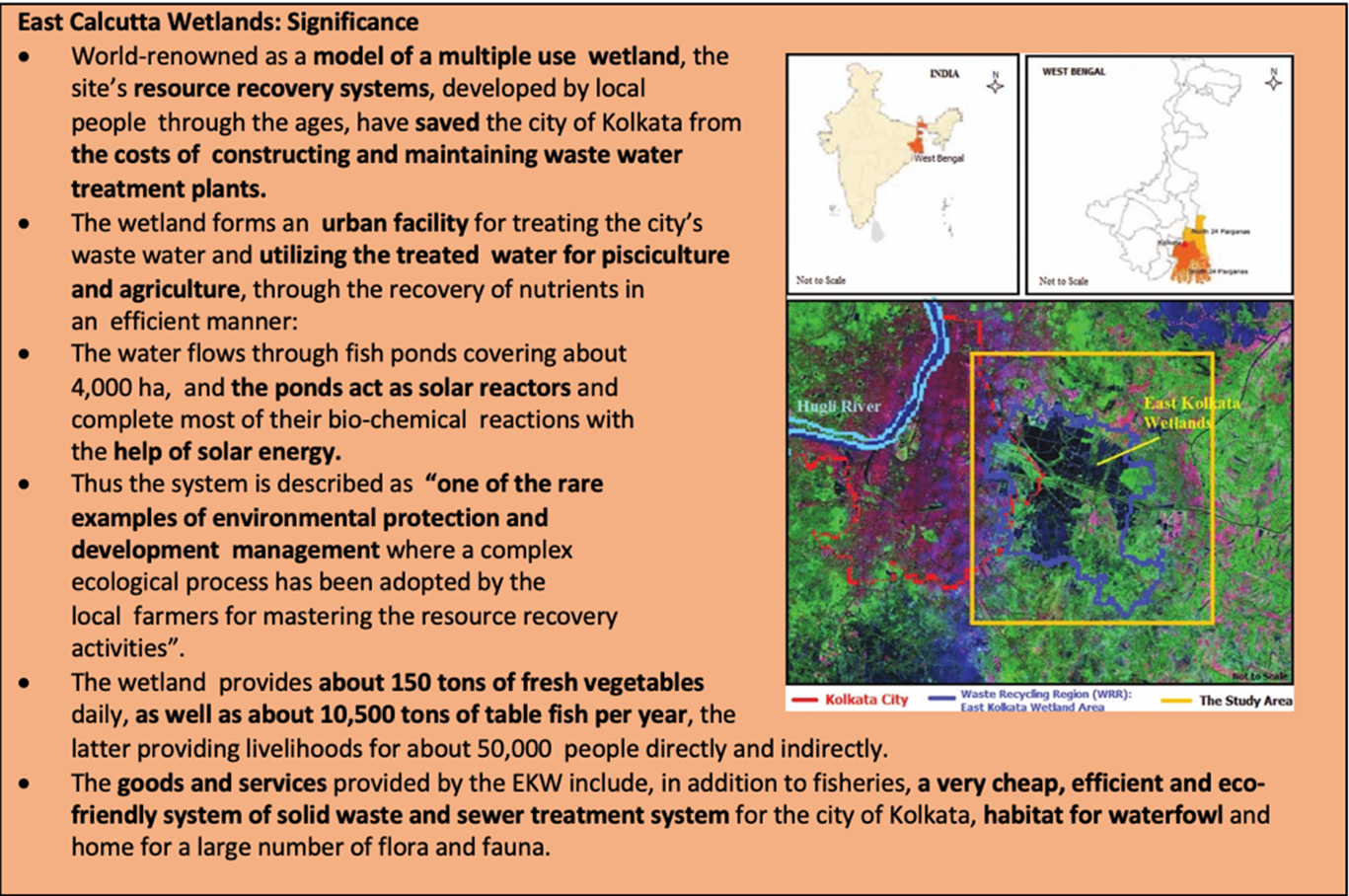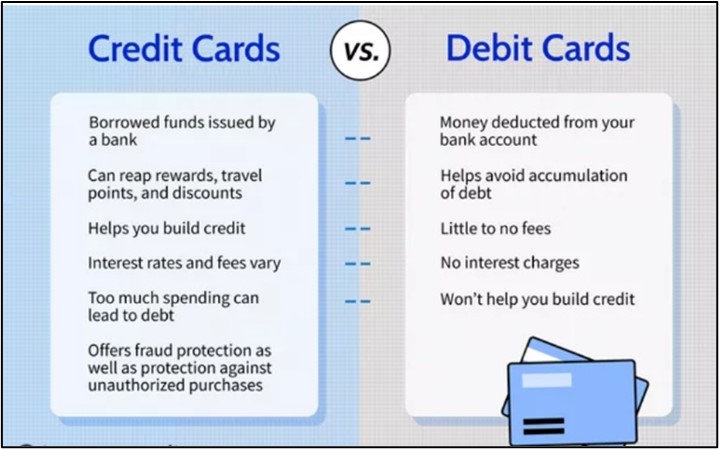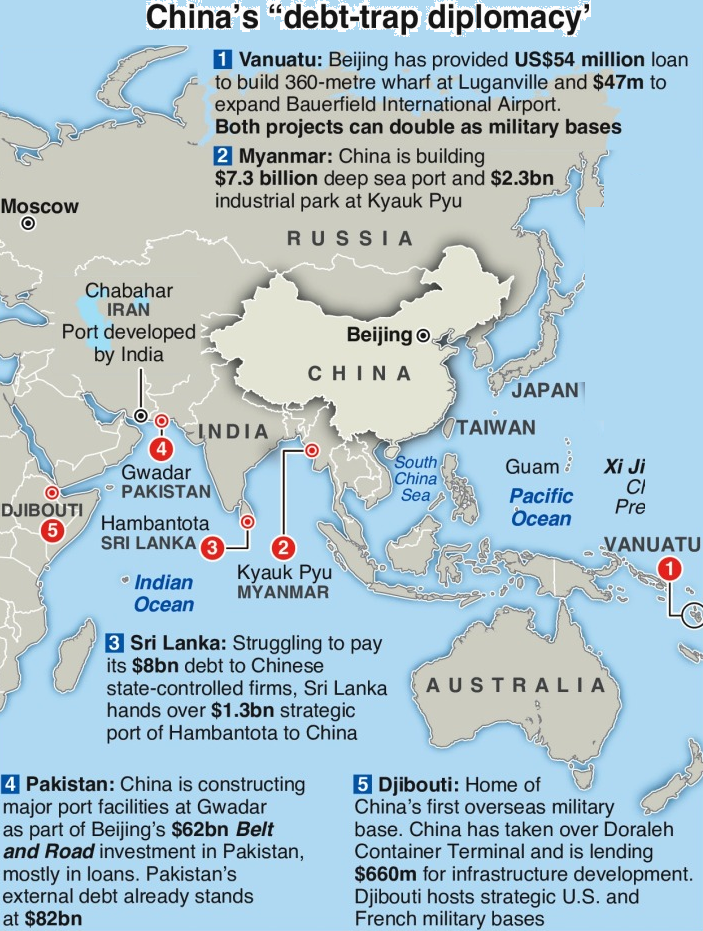Wednesday, 4th May 2022
P-75I Submarine Project
In News
Ahead of the Indian Prime Minister scheduled visit to France, its major defence company Naval Group has announced that it was unable to participate in the P-75 India project.
About the News
- P-75I is a naval project under which six conventional submarines are to be built in India for the Indian Navy.
- The Naval Group, one of the five shortlisted international players for project withdrawal from the process has raised concerns about the P-75I project.
- The government had issued the Request for Proposal (RFP) for the project in 2021 with the objective to build six submarines in India.
What is P-75I?
- About: The Project 75 (India)-class submarines, abbreviated as P-75I, is a planned class of diesel-electric submarines for the Indian Navy. It is the second project to build submarines in India and is successor of P-75 project.
- Outlay: The project aims construction of six units of submarines with an estimated cost of around 43,000 crores or $43 billion.
- Push for local: All the submarines are to be manufactured in India under the ‘Make in India’ initiative.
- AIP: Air-independent Propulsion is a technology for conventional submarines, and provides greater endurance, ability to remain submerged longer, and is less noisy than the diesel-electric propulsion system.

Why is the project important?
- Push to Aatmanirbhar Bharat: The project will nurture indigenous construction of six modern conventional submarines including associated shore support, engineering support package, weapons & sensors including fuel-cell based AIP besides, advanced torpedoes, modern missiles and state-of-the-art countermeasure systems.
- Capacity building: These conventional diesel-electric attack submarines are expected to include advanced capabilities such as AIP, Intelligence, Surveillance and Reconnaissance (ISR), Special operations forces (SOF), Anti-ship warfare (AShW), Anti-submarine warfare (ASW), Anti-surface warfare (ASuW), Land-attack capabilities, and other features.
- Forward and backward linkage: The project would provide a major boost to the indigenous design and construction capability of submarines in India, in addition to bringing in the latest submarine design and technologies as part of the project.
- Strategic need: As geopolitical fault lines become more prominent and China’s presence in the Indian Ocean Region is multiplied, it would do well for the Indian side to set the ball rolling and make the terms of its contract as also its technical requirements more feasible for foreign vendors.
What are the major issues?
- Skewed RPF: High indigenous content proportion 45 percent for the first submarine and 60 percent for the sixth one and nearly unlimited liability on the foreign technology partner, maybe impossible to meet.
- Rigid obligations: Despite the fact that the submarines are to be built in an Indian yard, the conditions placed a virtually infinite obligation on the foreign partner for the submarines’ performance.
- Low corpus: Considering the various criteria to be met, the budget of Rs 43,000 crore is criticized as being too low.
- Condition to be sea-proven: The Request for Proposal (RPF) requires that the fuel cell AIP be sea proven, which is not the case yet as the French Navy does not use such a propulsion system.
- Marred By Delays: The project has been in limbo after several unwarranted delays and pushbacks mainly because the majority of overseas participating companies finding it impossible to reach the original deadline.
- Technology sharing: Some of the Original Equipment Manufacturers (OEM) are not comfortable about sharing their expertise and niche technology with Indian partners.
Sources:
World Press Freedom Index
In News
As per the World Press Freedom Index 2022, India's ranking has fallen down to 150th position from last year's 142nd rank out of 180 countries.
About the News
- The Paris based Reporters Without Borders (RSF) publishes the World Press Freedom Index (WPFI) annually purporting to evaluate the level of freedom available to the media in 180 countries.
- It is being released since 2002 and it intends to reflect the degree of freedom that journalists, news organisations, and netizens have in each country, and the efforts made by authorities to respect this freedom.
- It is important to note that the index only deals with press freedom and does not measure the quality of journalism in the countries it assesses, nor does it look at human rights violations in general.
- The report is partly based on a questionnaire that deploys seven general criteria namely pluralism (degree of representation of opinions in the media space), media independence, environment and self-censorship, legislative framework, transparency, infrastructure, and abuses.
- The questionnaire takes account of the legal framework for the media including penalties for press offences, and the level of independence of the public media and also includes violations of the free flow of information on the Internet.
- A smaller score on the report corresponds to greater freedom of the press and vice versa.
Analysis of the Report:
- Leaders of the Table: Norway (1st) Denmark (2nd), Sweden (3rd) Estonia (4th) and Finland (5th) have grabbed the top positions this year, while North Korea remained at the bottom of the list of the 180 countries.
- India’s Ranking: India has fallen 8 points down to 150th position from last year's 142nd rank out of 180 countries. As per the report, the reasons could be:
- Targeting of journalists and increased online criticism for their work.
- Repetitive threats, harassment and detaining of journalists on politically motivated charges for their critical reporting.
- As per the report, the journalists are increasingly prosecuted by the government under counterterrorism and sedition laws.
- Therefore, the report has suggested that the authorities should conduct prompt, thorough, independent and impartial investigations into allegations of threats and attacks targeting journalists and critics, including from government officials.
- India’s Neighbourhood: The ranking of India's neighbours, except that of Nepal, have also slid down, with the index placing Pakistan at 157th position, Sri Lanka 146th, Bangladesh 162nd and Myanmar at 176th position.
- Ranking across the globe:
- Russia, which was previously ranked just 150, as a result of a decadelong crackdown on independent media, has fallen a further five places to 155, below Zimbabwe, Sudan and Libya.
- Hong Kong has registered the steepest drop in the ranking, falling 68 places to 148th, as Beijing continues to extend its information control over the semi-autonomous Chinese territory.
- Saudi Arabia (166th), has been labeled as having some of the world’s worst prisons for journalists.
- Myanmar's military coup last year sparked an extremely harsh repression of journalists, which saw the country fall to 176th in the rankings.
- The Taliban's seizure of power in Afghanistan (156th)also further worsened conditions for reporters and news organizations, who are often the targets of intimidation and violence.
- Increased Polarisation: There has been a two-fold increase in "polarisation" amplified by information chaos, that is, media polarisation fuelling divisions within countries, as well as polarisation between countries at the international level.
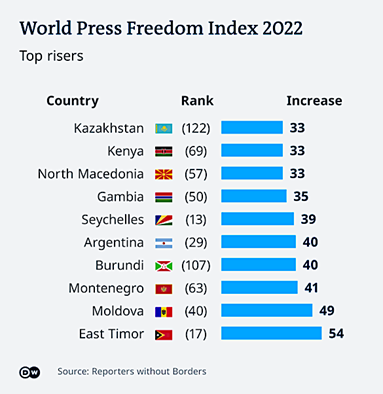
Source:
- India falls 8 positions to 150th rank in RSF 2022 World Press Freedom Index
- World Press Freedom Index 2022: India slips 8 places to 150th position
- RSF’s 2022 World Press Freedom Index : a new era of polarisation
Image source:
India-UAE CEPA (Update)
In News
The Comprehensive Economic Partnership Agreement (CEPA) between India and the UAE came into effect allowing most of the country’s exports a duty-free access to the Emirates.
About the News
- India will benefit from preferential market access provided by the UAE on over 97% of its tariff lines (or goods), which account for 99% of Indian exports to the UAE in value terms-particularly from labour-intensive sectors such as textiles, leather, footwear, sports goods, plastics, furniture, and engineering products.
- The CEPA with UAE covers trade in goods, trade in services, rules of origin, technical barriers to trade, sanitary and phytosanitary measures, dispute settlement, movement of natural persons, telecom, customs procedures, pharmaceutical products, government procurement, IPR, investment, digital trade and cooperation in other areas.
Important Clauses of India-UAE CEPA
- Rules of Origin: The RoO criteria adopted will allow the extension of preferential treatment for products that fall under the category of either 'wholly obtained or produced' or 'have undergone sufficient working or production'.
- It would curb the misuse of CEPA by other countries.
- FTAs have product-specific rules (PSR) and a specified code-wise harmonised system (HS).
- Sanitary and Phytosanitary Measures: The CEPA also provides the Sanitary and Phytosanitary Measures to protect human, animal, plant life or health in both the countries, to strengthen communication, consultation, and cooperation between the parties, to prevent any unjustified trade barriers, enhance transparency and to encourage the development and adoption of science-based international standards, guidelines, and recommendations, and promote their implementation.
- Trade in Services: India has provided market access to approximately 100 sub-sectors of the UAE regarding trade in services.
- In comparison, Indian service providers will have access to about 111 UAE sub-sectors from the 11 broad service categories such as business services, communication services, educational services, environmental services, financial services, health-related, tourism related services etc.
- Digital Trade: The CEPA also focuses on digital trade and provides that India and UAE shall endeavour to maintain a legal framework governing electronic transactions consistent with the UNCITRAL Model Law on Electronic Commerce (1996) and avoid any unnecessary burden on digital trade.
- The protection and enforcement of intellectual property rights (IPR) is expected to lead to the promotion of technological innovation and to the transfer and dissemination of technology.
- Export Promotion: The Indian Government’s emphasis is on export promotion in this agreement, and it is expected to be a valuable tool in the hands of the Indian industry to make inroads and boost merchandise trade to $100 billion over the next five years.
- It is also expected that the CEPA would generate 1 million jobs across multiple labour-intensive sectors.
- Government Procurement: The Parties recognise the importance of government procurement in trade relations and set as their objective the effective, reciprocal and gradual opening of their government procurement markets.
- Bilateral Cooperation on Pharmaceutical Products: The Parties, while recognising that there are differences between their health care systems, share a commitment to facilitate access of finished pharmaceutical products (FPPs), and certain marketed biological products for human use, which are collectively referred to as "Pharmaceutical Products", as a means of continuing to improve the health of their populations.

For article related to the topic, please refer:
Sources:
- All that glitters in this CEPA...
- Decoding India-UAE CEPA: Can it provide the roadmap for $100 billion in trade over the next 5 years?
- Comprehensive Economic Partnership Agreement (CEPA) between the Government of the Republic of India and the Government of the United Arab Emirates (UAE)
- India-UAE free trade pact comes into force
Justice Anna Chandy
On May 4, 1905 Justice Anna Chandy, the first woman judge of India, was born to Malayali Syrian Christian parents in Kerala. She was also also the first woman judge of the High Court of India. For decades before Elizabeth Lane, she was the first female judge in the entire Anglo-Saxon world. She joined the Court of Justice in the year 1928 and was appointed as District Judge (Munsif) by Sir CP Ramaswamy. While practicing as a lawyer since 1929, she was actively involved in promoting the cause of women's rights and their basic role in society. During her tenure, she gave birth to women's career hopes in the legal field of India. Anna along with advocating for women’s rights also found and edited her magazine Shreemati for a similar concern. During her retirement, Anna served in the Law Commission of India, and with that she also wrote her autobiography named Aatmakatha.

Sources:
India’s Wheat Journey
In News
Recently, Egypt, one of the world’s biggest importers of wheat which has been importing the grain from Russia and Ukraine, has agreed to source supplies from India.
A brief History of Wheat in India
- The earliest wheat excavated from an Indian site of Chirand (in Saran district of Bihar) is estimated to be from c. 3500 B.C.
- During the Harappan period (2300-1750 B.C.), wheat has been discovered from Harappa, Mohenjo-daro, Chanhu-daro in the Sindh valley. Carbonised wheat grains from the late levels of Mohenjo-daro have been radiocarbon dated to 1755 B.C.
- Evidence has shown that the earlier wheat variety T. sphaerococcum. found in Harappan, Chirand, Ter sites have been completely wiped out in modern times and replaced by better yielding cultivar of T. aesitvum.
- Evidences prove that, from Mehrgarh, wheat moved east, reaching Chirand 3500 B.C. through the vast plains of Ganga and Yamuna.
- The movement of wheat to central and south India seems to have been mainly restricted by forests and the ranges of Vindhya and Satpura hills until one or two centuries before the beginning of the Christian era when it crossed over these barriers along with the moving caravans from east to south.
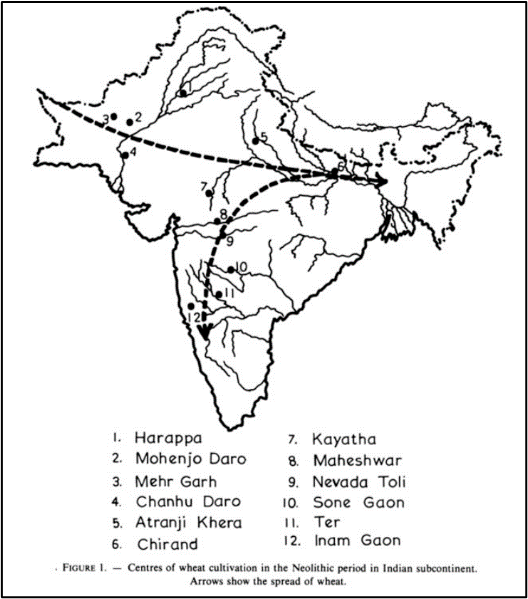

Wheat Production post-independence
- Wheat crop is India’s prime most staple harvest, placed second only to rice.
- Mainly three types of wheat are grown in India – aestivum or bread wheat, T.durum or macaroni/pasta, T.dicoccum or Emmer.
- After 1947, India was net deficit in food production and had to import wheat to feed the population.
- With the introduction of All India Coordinated Wheat Improvement Project (AICWIP), ‘Green Revolution’ began in India in the 1960s. India’s wheat crop production and productivity increased at a great level.
- Major wheat growing states in India are Uttar Pradesh, Punjab, Haryana, Madhya Pradesh, Rajasthan, Bihar and Gujarat.
- In the current scenario, India's wheat harvest is expected to rise to 110 million mt in the crop year 2021-22 (July-June), from 108 million mt a year ago.

World wheat production:
- Wheat is the second-most-produced cereal grain behind maize, and the global trade of wheat is greater than all other crops combined.
- In 2020, the total global production of wheat was 760 million tons.
- China, India, and Russia are the three largest individual wheat producers in the world, accounting for about 41% of the world’s total wheat production.
- Highest exporters of wheat in 2020 were Russia, USA, Canada, France and Ukraine.
Challenges to Wheat production in India
- Climatic vulnerability: Wheat production not only faces the above routine challenges, but the intensity gets magnified in the context of climate change owing to its vulnerability.
- Excessive use of inputs and land resources: The excessive use of fertilizer, chemicals and irrigation has degraded the fertility of the soil and also caused a reduction in groundwater table. The mono cropping system led to deterioration in soil quality.
- Salt-affected and problematic soils: In India about 4.5 million hectares salt affected area is under wheat cultivation posing a major problem for canal irrigated areas.
- Pest and disease complex: As year passes, the pests of wheat have developed some resistance even though controlled under contingent situation.
- Availability of improved seed: A majority of farmers in India have lack of awareness of improved wheat varieties due to weak linkages. The development and diffusion of improved varieties are crucial for achieving target production of wheat.
- Price volatility: Price fluctuations create an uncertain farming situation threatening wheat production and have a negative impact on the welfare of wheat growers. Further, volatility in prices of wheat in international market hinders the smooth flow of trade across nations.
- Decline in farm size: Decline in farm size has been a major hurdle as small farmers struggle to keep up with the demand of high productivity.

Opportunities for India now
- Due to the Russia-Ukraine war, world wheat trade has been affected, both countries being a major exporter of wheat globally.
- India, the world's second biggest wheat producer, is prepared to meet any extra demand for wheat from buyers in south Asia and Southeast Asia, and from countries further afield in Europe, West Asia and North Africa.
- Egypt, one of the world’s biggest importers of wheat has agreed to source supplies from India.
- Growth in wheat export in India is driven mostly by the demand from countries such as Bangladesh, United Arab Emirates, Qatar, Sri Lanka, Oman and Malaysia.
- However, India is making efforts to boost wheat exports to other countries including Yemen, Afghanistan and Indonesia.
- India's new season wheat harvest is underway, with this year's production pegged at a record 111.32 million tonnes - making it the sixth season in a row that the country has produced a surplus.
- The Indian market has sufficient stocks, and India is in a comfortable position to meet requests from wheat importing countries.
- India needs at least 25 million tonnes of wheat each year to run a food welfare programme.
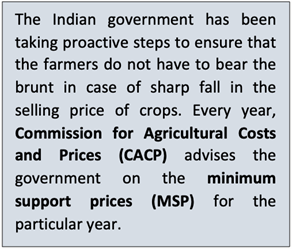
Conclusion: India has come a long way since independence in terms of wheat production. From a deficit country, production has been in surplus and exports have been rising, owing to the Green Revolution in the 1960s. The geopolitical tensions and changing world order provides India with a rare opportunity to build on the momentum and cement its image as an exporter of food grains.
Question: Discuss the challenges faced by India in expanding its wheat production. What can be done to overcome these challenges
Sources:
- Egypt to import wheat from India
- Wheat production in India- Trends and Prospects
- Wheat Production in India: Technologies to Face Future Challenges
- Current Research status and future challenges in wheat production in India
- Record wheat crop, high stocks to help India meet rising global demand
- Farmers’ Portal
- India's wheat export boom brings a bonanza to farmers, and budget relief
- APEDA- Wheat
- History and Ethnobotany of wheat in India
- Wheat Crop In India – The Productivity Woes
- Wheat Production by Country 2022
- Standard and Poor- India Wheat Production
Asia’s 1st Grandmaster
This is image Mir Sultan Khan, Asia’s 1st Grandmaster. Through the late 1920s and early ‘30s, Mir Sultan Khan took the world of chess by storm. In an international career that barely spanned five years, Sultan won the prestigious British Chess Championship in 1929, 1932 and 1933, and defeated a series of ‘White’ masters of the game including Akiba Rubinstein, Salo Flohr, José Raúl Capablanca and Savielly Tartakower. Called a ‘genius’, the ‘greatest natural player of modern times’ and ‘Asia’s first grandmaster’ on different occasions, Sultan Khan’s remarkable story has been largely forgotten. His playing style was also dubbed the ‘Wrath of Khan’. At the time of Partition, Sultan decided to stay back in present-day Pakistan. Born in 1903 in the village of Mitha Tiwana, Khushab district (present-day Pakistan), Sultan came from a family of pirs (Sufi spiritual guides) and landlords belonging to the Awan tribe, which traced their lineage all the way back to the Mughal era.
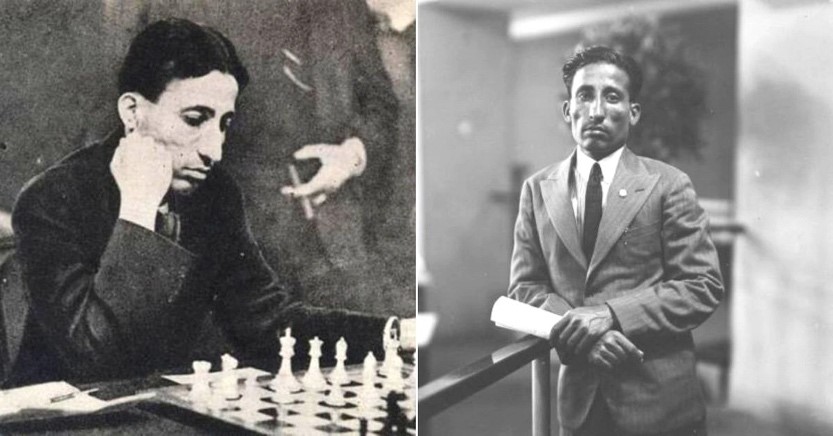
Source:
Gujarat Foundation Day
- Context: The Prime Minister had recently greeted the people of Gujarat on its foundation day.
- May 1 marks the foundation day of Gujarat, along with the state of Maharashtra.
- It was on this day in 1960 that the erstwhile state of Bombay was divided on linguistic basis into two states namely Gujarat and Maharashtra after the enactment of the Bombay Reorganisation Act, 1960.
- Writer and freedom fighter KM Munshi had first suggested a concept called Mahagujarat in a meeting held in Karachi in 1937.
- Gujarat, often called as ‘Jewel of Western India’, has always played a major role in the businesses of Karachi and Mumbai during the British Raj.
- The major agricultural produce of the state includes cotton, groundnuts, sugarcane and milk products.
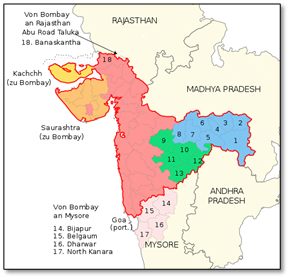
Source:
- PM Modi greets people of Gujarat, Maharashtra on their statehood day
- Gujarat Day 2021: Know history, significance of foundation day of the 'Jewel of Western India'
- Gujarat, Maharashtra celebrate foundation day; President, PM greet people
Image source:
Char Dham Yatra
- Context: Uttarakhand government has recently issued guidelines for Char Dham Yatra, which is scheduled to commence shortly.
- Chardham Yatra of Uttarakhandis one of the most popular pilgrimage circuits of India, connecting four most sacred places of the Indian Himalayas namely Yamunotri, Gangotri, Kedarnath and Badrinath.
- In actual Char Dham refers to set of four pilgrimage sites in India. The four Dhams are Badrinath, Dwarka, Puri and Rameswaram.
- According to Hindus, visiting these four religious destinations will give one salvation/
- The starting point of Chardham Yatra is Haridwar, from where pilgrims begin their journey to the four holy shrines.
- They visit Yamunotri (source of River Yamuna), then to Gangotri (located at Gomukh, source of the river Ganga), followed by the Kedarnath Dham, and finally end the pilgrimage at the Badrinath Dham (left bank of the Alakananda River, where Adi Shankaracharya is believed to have attained salvation)
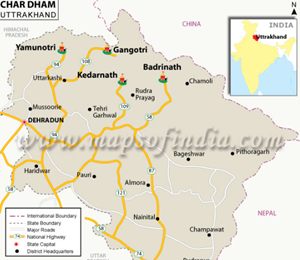
Source:
Image source:
Kisan Drones
- Context: The Union Minister of Agriculture and Farmers Welfarehas recently inaugurated the conference on Promoting Kisan Drones.
- Kisan Drones have been launched with the aim to boost the agricultural sector of the country
- It will help in promoting crop assessment, digitisation of land records and will further aid in spraying insecticides and nutrients evenly on farmlands.
- It intends to promote chemical-free natural farming, for carrying vegetables, fruits, fish, and other products directly from the farms to the market.
- This will not only cause minimal damage to the commodities but will also minimise the time consumption and maximise profits to the farmers and fishermen.
- The development of the drone market will also boost employment generation in the country.
- In this perspective, Garuda Aerospace has set a target of manufacturing 1 lakh Made-in-India drones in the next 2 years.

Source:
- What is Kisan Drone? Five things you should know
- PM Modi launches 100 Kisan drones in unique farm blitz
Image source:
National Open Access Registry (NOAR)
- Context: National Open Access Registry (NOAR) has successfully gone live from 1st May 2022.
- NOAR is a centralized online platform through which the short-term open access to the inter-state transmission system is being managed in India.
- It is an integrated platform accessible to all stakeholders in the power sector, including open access customers (both sellers and buyers), power traders, power exchanges, National/Regional/State load despatch centres etc.
- Its key features include:
- Centralized System: Single point electronic platform for all the stakeholders.
- Automated Process: Automated administration process of the short-term open access.
- Common Interface: Interface with the Regional Load Despatch Centers (RLDCs) scheduling applications and Power Exchanges.
- Payment Gateway: Make payments related to short term open access transactions
- It has number of Benefits such as simplified accounting of transactions, better communication and updated information, bringing in transparency, efficiency and Standardization and mapping of the entities.
- National Load Despatch Centre (NLDC) operated by Power System Operation Corporation Limited (POSOCO) is the nodal agency for implementation and operation of NOAR.

Source:
Image source:
Maritime governance: A robust blue economy needs blue diplomacy: Hindustan Times
Essence: The article is written in the context of the India-France Roadmap on Blue Economy and Ocean Governance, announced in February 2022. The concept of Blue Economy (BE) began after the United Nations Conference on Sustainable Development, 2012 as the Small Island Developing States (SIDS) urged special consideration of their challenges to survive and develop through ocean-based economic activities depicted as BE.
India is promoting BE through multilateral forums such as Indian Ocean Rim Association, held workshops with the Association of Southeast Asian Nations (ASEAN) to develop policy convergence and joint BE projects, launched Indo-Pacific Oceans Initiative (IPOI) at the East Asia Summit in 2019 to address various aspects of BE, implementing Sagarmala programme and holding bilateral discussions between India and Bangladesh, Sri Lanka and the Maldives.
The author recommends elevating the draft policy framework to official policy, engaging business and industry in blue diplomacy, establishing a centralised BE unit in the ministry of external affairs and bringing BE within the ambit of cooperation among Quad countries to promote blue diplomacy.
Why should you read this article?
- To know about the origin and importance of Blue Economy.
- To know about the India`s commitment and initiatives undertaken to promote Blue Economy.
- To know about the authors recommendations to promote Blue Diplomacy.
Source:
Definitions are important for poverty measurement: Live Mint
Essence: The editorial talks about the estimation of poverty in India, the recall period and issues related to it. Firstly, there is a need to raise the poverty line from current $1.9 to $3.2 which would be equivalent to change from Rs52 to Rs88 and total to Rs1.6 Lakh a year form a family. This would capture approx. 20% of India’s population in the relative poverty levels.
The issue, however, is the usage of various definitions related to per capita consumption. Perishables like vegetables and fruits should have a recall period of 1 week, period items like toothpaste, visit to doctor and club fees a recall period of 30 day and durables (clothing, car, carpet, furniture, etc.) could use a recall of 365 days. The recall is supported by common-sense justification of memory and accuracy.
These methods of recall translate to what is known as uniform recall period (URP 30 days), mixed reference period (MRP) and a modified mixed recall period (MMRP). Though the use of MMRP has been accepted widely as it has a small recall time of 7 days for perishables, yet world bank continues to estimate poverty in India with wider recall period. This outdated data leads to expansion in numbers of poor in India, which is not representative of the real poverty.
Why should you read this article?
- To know the types of recall period and the item basket in each of them.
- To understand the issues related data collection on poverty estimation.
Source:
On Ukraine, India must choose a side: Indian Express
Essence: The editorial provides an insight into India’s relationship with EU nations- Germany, France and Denmark amidst Ukraine crisis. The formation of India-Europe Trade and Technology Council provides a leap into India and Europe relations. Germany and India, both, will need to learn to navigate and disentangle themselves from relationship with Russia and trade with China. Germany’s annual trade with Russia is $60Bn, which includes natural gas and with India is $10Bn, of which an important component is weaponry. Denmark is an important country in Nordic region and the economy of Nordic Five- Denmark, Finland, Iceland, Norway and Sweden- together is bigger than Russia’s. The 2 members of Nordic, Sweden and Finland are under strategic burden to accept Russia’s supremacy or join NATO. India looks forward to the next phase of partnership with France- a major ally, defense supplier, nuclear fuel and technology provider, etc.
Stronger commercial and security partnerships with European countries will help India in bringing synergies in diplomacy and trade.
Why should you read this article?
- To understand the threats to Europe from Russian invasion.
- To know the dimensions of partnership between India and Europe.
Source:
It Takes a Village to Keep Girls in School
Background
- Education for girls is a difficult subject in India. This became more problematic during the epidemic, when adolescent girls made up 40% of the estimated 30 million out-of-school
- Initiatives such as Educate Girls address the impact of poverty and patriarchy on girls' access to education, school, and opportunity.

How It Takes a Village to Keep Girls in School:
- Organizations such as Pratham Foundation and Educate Girls have conducted extensive surveys and sensitization campaigns in rural communities in order to establish a strong team of local change agents.
- Since its inception in 2007, Educate Girls has enrolled over 5 lakh girls in school in over 20,000 villages across Rajasthan, Madhya Pradesh, and Uttar Pradesh.
- It has assisted over 3 lakh adolescent females in receiving life skills training, allowing them to develop decision-making agency and gain greater control over their lives.
- This impact is the result of the 14-year efforts of 15,000-strong armies of village-based Team Balika volunteers. These volunteers have accomplished a great deal, from going door to door to locate out-of-school girls to convincing all stakeholders, including their parents, of the necessity of girls' education.
- When a community comes together to take ownership and responsibility for empowering its girls and women, half of the battle is won since the community plays a critical part in assisting a girl to receive an education and stay in school.
Quote: Women, like men, must be educated with a view to action, or their studies cannot be called education.– Harriet Martineau
Source:
Share the article
Get Latest Updates on Offers, Event dates, and free Mentorship sessions.

Get in touch with our Expert Academic Counsellors 👋
FAQs
UPSC Daily Current Affairs focuses on learning current events on a daily basis. An aspirant needs to study regular and updated information about current events, news, and relevant topics that are important for UPSC aspirants. It covers national and international affairs, government policies, socio-economic issues, science and technology advancements, and more.
UPSC Daily Current Affairs provides aspirants with a concise and comprehensive overview of the latest happenings and developments across various fields. It helps aspirants stay updated with current affairs and provides them with valuable insights and analysis, which are essential for answering questions in the UPSC examinations. It enhances their knowledge, analytical skills, and ability to connect current affairs with the UPSC syllabus.
UPSC Daily Current Affairs covers a wide range of topics, including politics, economics, science and technology, environment, social issues, governance, international relations, and more. It offers news summaries, in-depth analyses, editorials, opinion pieces, and relevant study materials. It also provides practice questions and quizzes to help aspirants test their understanding of current affairs.
Edukemy's UPSC Daily Current Affairs can be accessed through:
- UPSC Daily Current Affairs can be accessed through Current Affairs tab at the top of the Main Page of Edukemy.
- Edukemy Mobile app: The Daily Current Affairs can also be access through Edukemy Mobile App.
- Social media: Follow Edukemy’s official social media accounts or pages that provide UPSC Daily Current Affairs updates, including Facebook, Twitter, or Telegram channels.

